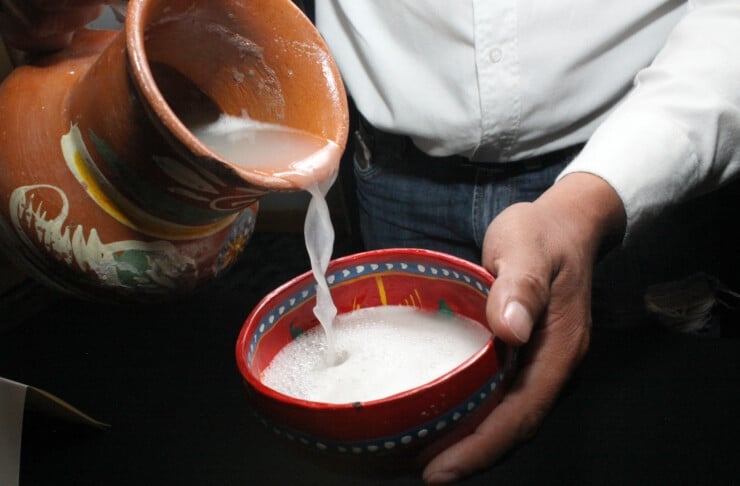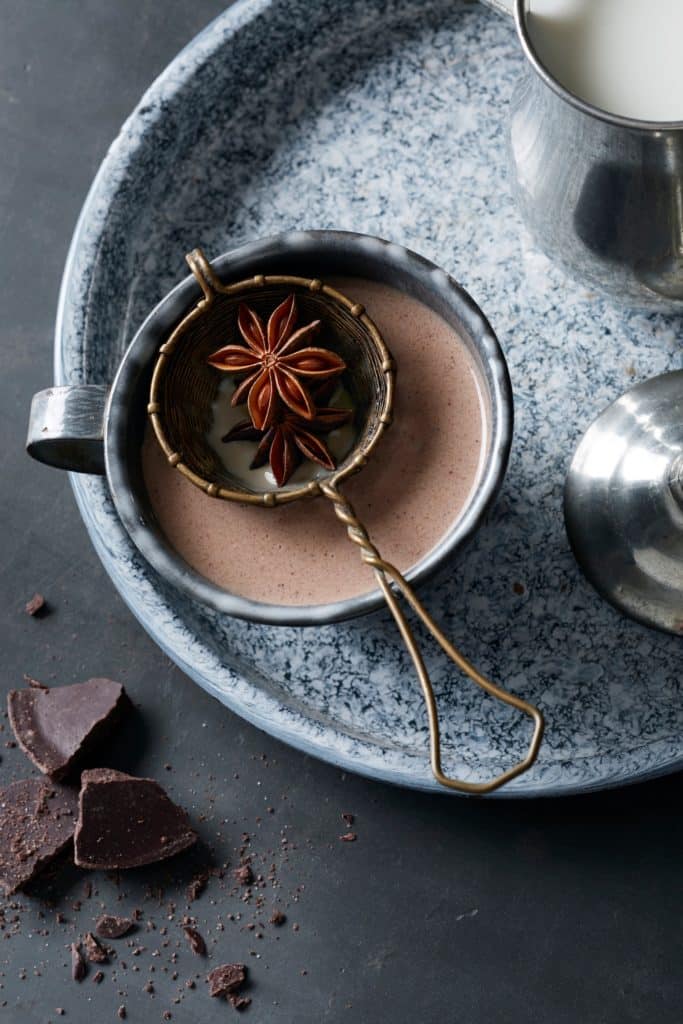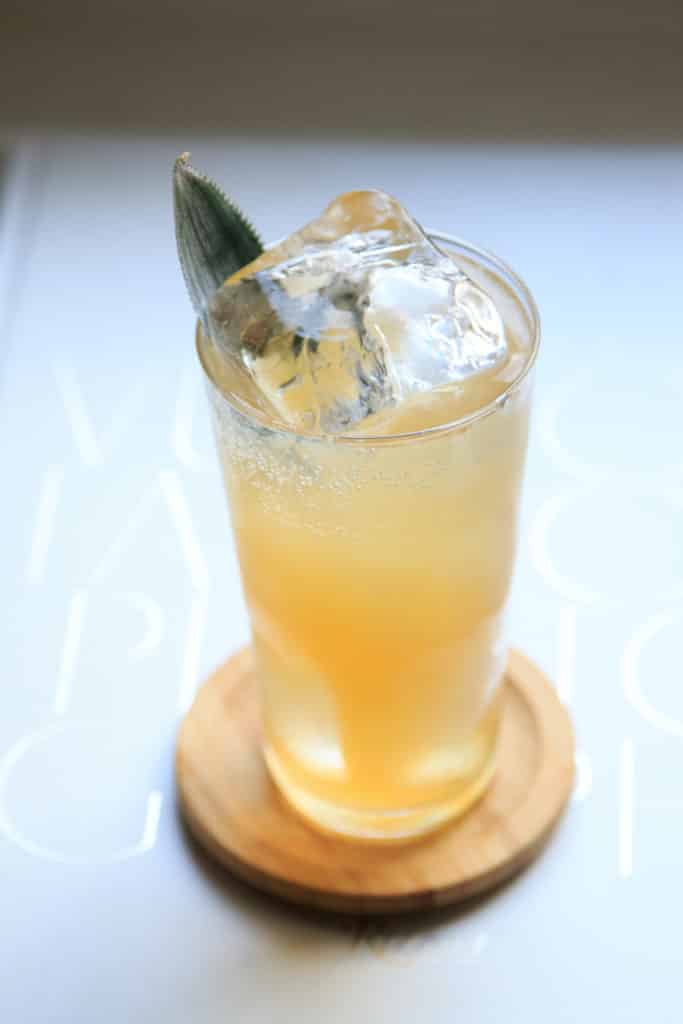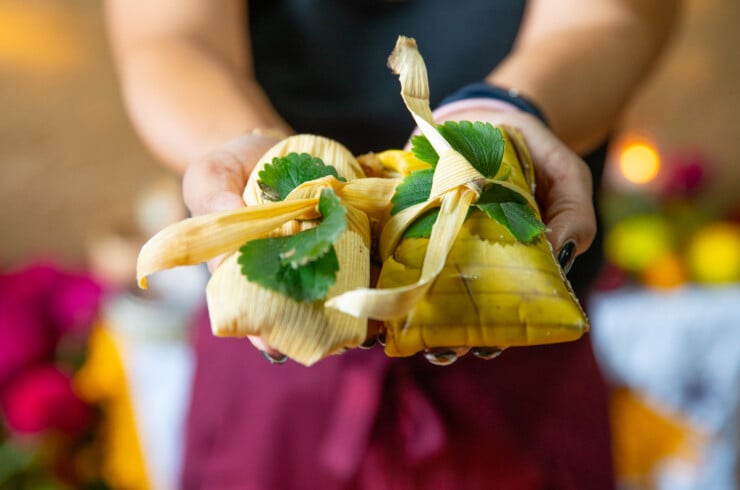You know the saying “everything old is new again?” Well, it’s very much true when it comes to Mexican beverages. Case in point: some classic yet under-the-radar Mexican beverages are making their way onto hip cocktail menus.
Maybe you’ve sipped fizzy tepache or boozy pulque and pondered the roots of these classic drinks. And classic they are as they have been part of Mexican culture for millennia. In this article we are uncovering the history of these 8 Pre-Hispanic Drinks To Sip In Mexico.

8 Pre-hispanic Drinks To Try In Mexico
Indigenous Mesoamericans like the Olmec, Aztecs, and Mayas prepared non-alcoholic and alcoholic beverages using native ingredients like corn and cacao.
Here we’re sharing some Mexican drinks that have been around long before the Spanish arrived. Some can be hard to find stateside, but we consider it just one more reason to visit Mexico IRL.
Atole, Central Mexico
The pre-Columbian beverage atole might just be the original breakfast cereal, seeing as most breakfast cereals are corn-based and sweetened. Stay with us here: atole–from the Nahuatl word, “atolli“–is a dense, corn-based drink made from masa, or nixtamalized corn dough, and water.
During nixtamalization, dent corn, a starchier variety than the corn we eat off the cob, is soaked in the mineral lime, ground, and mixed with water. Add chocolate to atole, and it becomes champurrado (Cocoa Puffs, is that you?) This process makes the corn easier to digest and ups its nutrition factor.
Cornmeal or cornstarch is also used to make atole, but the ideal consistency is smooth and lump-free, no matter the ingredients.
Regional versions include atole made with chocolate, black pepper, and star anise in the Yucatán. While in Michoacan, changunga fruit (also known as nanche in other parts of Mexico) is added. Atole is typically consumed for breakfast (often with a tamal), after dinner, and during holidays like Dia de Muertos and Christmas.

Champurrado, Central Mexico (Oaxaca)
One variation of atole variations is champurrado, where cacao, corn masa, and water create a thick hot chocolate drink. Not to be confused with Mexican hot chocolate (which doesn’t have corn masa), champurrado is often sweetened and spiced with piloncillo sugar, star anise, and cinnamon and made with milk.
Champurrado is especially popular during Dia de Muertos, Las Posadas, and Christmas, and for breakfast when it’s typically accompanied by pan dulce (sweet bread). While champurrado is available all over Mexico, it’s especially prevalent in Oaxaca (aka land of chocolate), where ancient Olmecs and Mayans prepared drinking chocolate.
Pozol, Southeastern Mexico (Tabasco)
Kale and açai may be modern-day superfoods, but pozol (not to be confused with pozole) was the Mayan culture’s super drink. The word pozol comes from the Nahuatl word, “pozolli,” meaning “corn” or “corn stew,” and it was traditionally used as an energy drink, a thirst quencher, and to quiet hunger pangs.
Pozol is made with fermented corn dough that first has undergone nixtamalization–as in the same process used to make masa for tortillas and tamales.
Pozol is widespread throughout southern Mexico, including in Tabasco and Chiapas, and sometimes also in Oaxaca and parts of Central America. Pozol is traditionally served in a hollow, dry gourd called a jícara and is often served with sugar or milk.
In Tabasco, the traditional way to drink pozol is without sugar (sin azucar), accompanied by candied papaya or coconut, or with salt and chile. Variations include pozol con cacao, con camote (sweet potato), and the fermented, sour pozol agrio.
Pulque, Central Mexico (Mexico State, Tlaxcala, Puebla, Hidalgo)
Most commonly found in Central Mexico, pulque is an alcoholic beverage that has been around for thousands of years. It was considered the drink of ancient Aztec, Mayan, and Huastec gods before becoming the people’s drink.
Like tequila and mezcal, pulque is made from the agave plant, specifically maguey, or mature agave. The difference is that the maguey sap is flash-fermented to make pulque, while the agave for tequila and mezcal is fire-roasted before fermentation and distillation. Fermenting the raw sap produces an effervescent, low-alcohol beverage in a matter of hours.
Pulque is best enjoyed fresh, which is why (good) pulque doesn’t make it very far outside central Mexico. For example, it’s all over Mexico City, especially in the super casual dive bars known as pulquerias. Try the milky (in color), fizzy, pulque plain, or flavored curados in any number of fruity, nutty, and spicy combos.
Locals tip: Try pulque the traditional way and drink it from a pebbled glass cacariza.
Sotol, Northern Mexico (and present-day West Texas, New Mexico, Arizona)
Sotol is the regional spirit of northern Mexico, including the state of Chihuahua, and parts of present-day Texas, New Mexico, and Arizona. During Mesoamerican times, sotol–made from the desert spoon plant–was fermented into alcohol.
Most people in the U.S. don’t know too much about sotol because up until the early nineties, sotol production was illegal. In the mid-1900s, the Mexican government banned sotol production for various rumored reasons. Even so, sotol did manage to make it across the border during U.S. prohibition (1920–1933).
As such, though sotol is thousands of years old, it’s just getting started in terms of the U.S.’ knowledge and preference for Mexican spirits.
Tejate, Southern Mexico (Oaxaca)
If champurrado is a warm chocolate drink, the pre-Hispanic drink tejate is its chilled counterpart. Tejate is also made with corn and cacao. Still, it also calls for rosita de cacao, a rare flower (and despite the name being unrelated to cacao) found in the small town of San Andres Huayapam in Oaxaca.
Tejate was likely used by indigenous Aztec, Zapotec, and Mixtec cultures in religious ceremonies. At the same time, today, frothy tejate is traditionally prepared by women in Oaxacan markets, including San Andres Huayapam, where the drink originated.

Tepache, Central Mexico (Jalisco)
In ancient times, Mayans and Nahua people likely made a corn-based drink called tepache. Today, the drink known as tepache is a low-alcohol, slightly effervescent beverage made from fermented pineapple, sugar, and spices.
Pineapple, cinnamon, and piloncillo (unrefined brown sugar, also known as Mexican brown sugar) are found in tepache recipes all over Mexico with regional variations–though the drink is most closely associated with the state of Jalisco.
In Mexico, street vendors sell tepache in plastic baggies with a straw. But the drink has garnered attention from bars and restaurants in the U.S., where tepache is mixed into tequila and mezcal-based cocktails.
Xtabentún, Southwestern Mexico (Yucatán)
This sweet liqueur is rooted in the Mayan ceremonial drink balché, made with fermented Melipona honey–from stingless bees–and bark. Anise was added when the Spanish introduced it, and still, only a handful of producers make it with rum and honey from the Xtabentún flower.
Xtabentún is regional to Yucatán and Quintana Roo and is typically enjoyed straight, chilled, with honey and ice. It’s served as an after-dinner tipple and added to coffee and cocktails. In major cities like Cancun, Xtabentún is commonly used in desserts.
Yolixpa, Central Mexico (Puebla)
Another pre-colonial beverage is yolixpa, which translated from Nahuatl, means “heart medicine.” It’s best associated with a little town called Cuetzalan, located north of the city of Puebla in Puebla state. It tastes more on the bitter side, as more than twenty herbs like mint, oregano, sage, and salvia–plus aguardiente–are used to make yolixpa.
Originally, yolixpa was used by curanderos–traditional healers–for medicinal purposes. These days, it’s likely sweetened with honey or cane sugar and even has its festival in Cuetzalan.
And while we can indeed find these drinks in the U.S., if we search hard enough, we’d rather experience these liquid traditions first-hand, aka from the source!
Get A Personalized Travel Itinerary

What Is A Tamal?
If you’re here, you’re likely as into food culture and history as we are! Keep learning about Mesoamerican food and drinks and read up about “what is a tamale?” From the history to the types you’ll encounter in Mexico and tips on how to make tamales, we’ve got your covered.
Get Ready To Travel To Mexico
Thinking of traveling to Mexico soon? Our travel planning services are here to help you have the ideal vacation. After discussing your preferences during a short consultation, we’ll plan your perfect itinerary. Whether you’re looking for custom travel planning or a small group trip, the Salt & Wind team is here to help. Contact us today to learn more!
Photo Credit: Pulque photos by By Angel Malo; champurrado by By Image Source Trading Ltd; tepache by By SergeUWPhoto